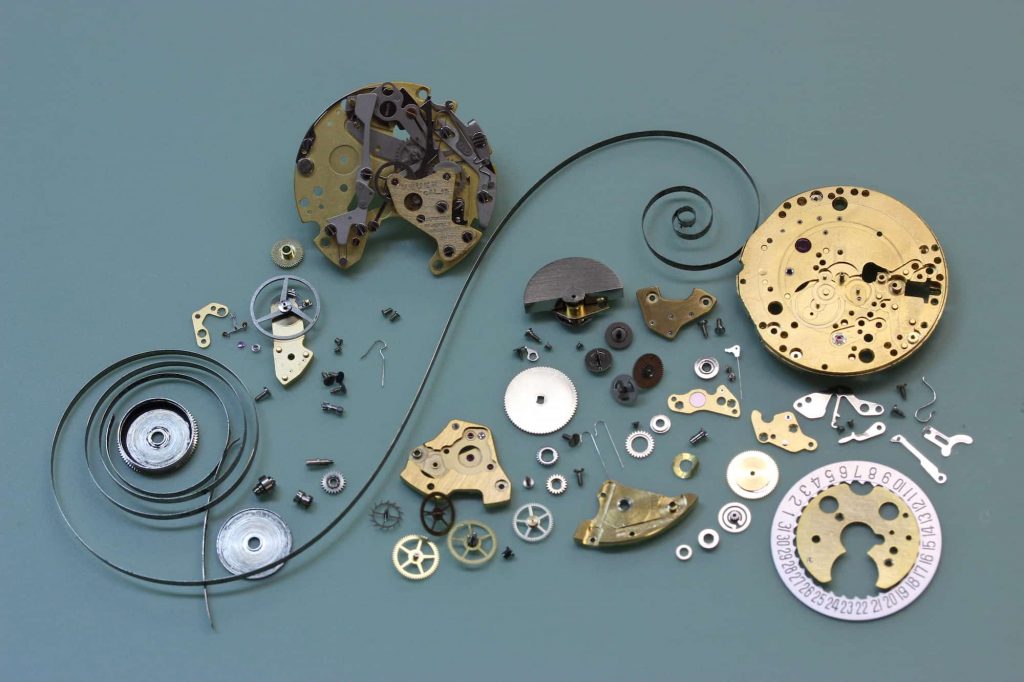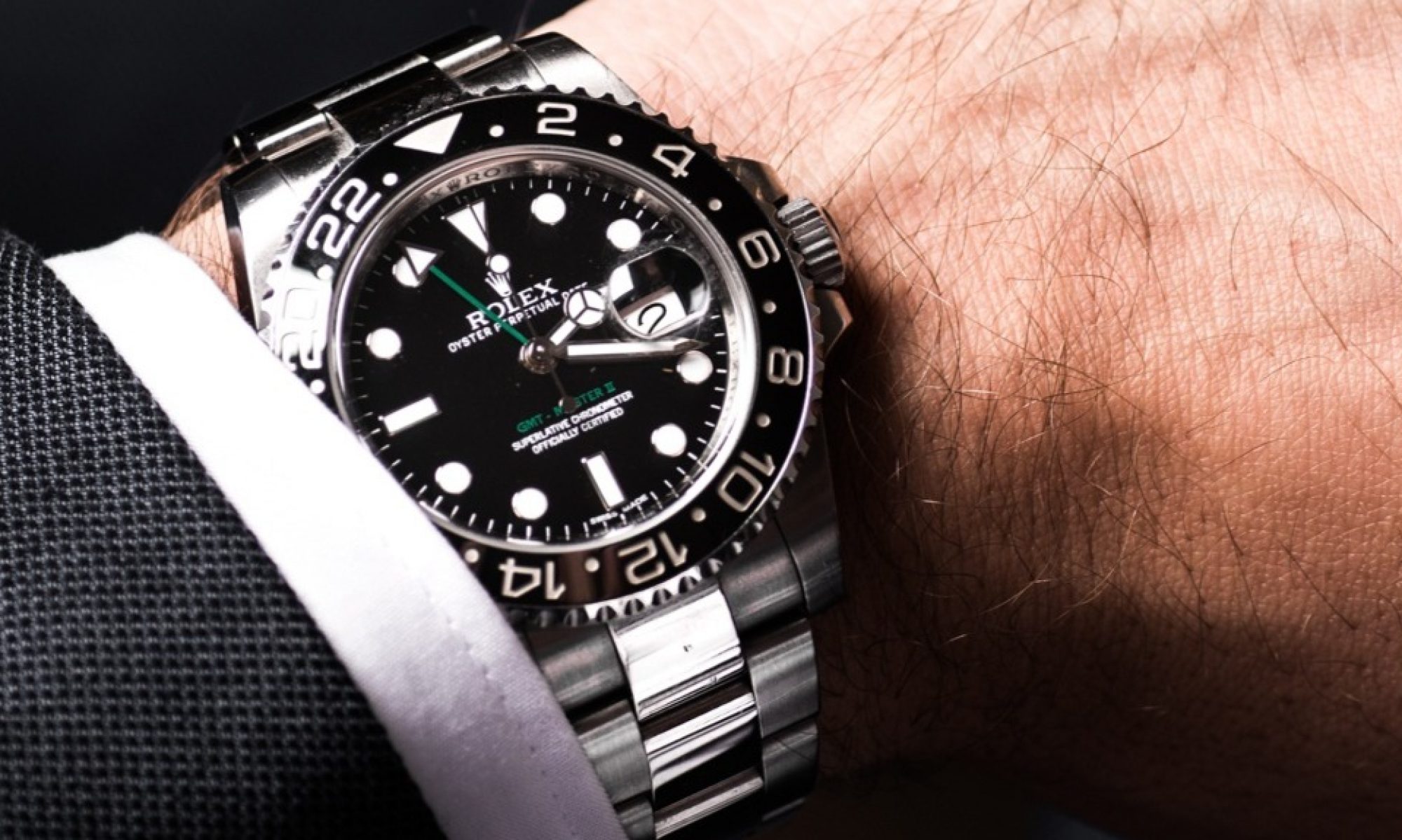In addition to their exterior beauty, replica watches are also an incredible feat of engineering and craftsmanship. Many complicated parts must all work in tandem in order to not only tell time but perform the myriad other functions that many of today’s watches perform. This section contains an overview of the major parts of a replica watch, as well as an explanation of how watches operate.
How a replica Watch Works
Watches essentially tell time by the integration of three main components: an energy source, a time regulating mechanism and a display. The energy source can be electronic (as in a battery) or mechanical (as in a wound spring). A watch’s main timekeeping mechanism is called its movement. Today’s watches fall into two categories: Mechanical movements and Quartz movements. Here’s a breakdown of how each type of movement works:
Mechanical (Automatic) replica Watches

The traditional mechanical watch is made up of about 130 parts assembled in the three main parts, which are the source of energy, the regulating parts and the display. Automatic mechanical movements mark the passage of time by a series of gear mechanisms, and are wound by the movement of your wrist as you wear it. The gear train then transmits the power to the escapement, which distributes the impulses, turning the balance wheel. The balance wheel is the time regulating organ of a mechanical watch, which vibrates on a spiral hairspring. Lengthening or shortening the balance spring makes the balance wheel go faster or slower to advance or retard the watch. The travel of the balance wheel from one extreme to the other and back again is called oscillation. A series of gears called the motion work, then turns the hands on the watch face, or dial.
The number of component parts is much higher in so-called complicated Luxury Replica omega watches (date, phases of the moon, fly-back hand, etc.). The “ébauche” (about 60 parts) fitted with the regulating and certain other parts, forms the movement, in other words the internal mechanism of the watch, which makes it possible to maintain a constant tension in the spring once it has been wound manually or automatically (by movements of the wrist) and to regulate the display by means of the hands (hours, minutes, seconds). A watch is said to be finished when the movement has been fitted with a dial, hands, and case.
A mechanical replica watch
1) Barrel/mainspring providing the power
2) Gear train, transmitting the power
3) Escapement, distributing the impulses
4) Balance wheel & hairspring, oscillating, making the division of time
5a) Winding stem, for manual winding and setting
5b) OscillatingwWeight, for automatic winding
6) Dial train, activating the hours, minutes, seconds hands
The combination of these two technologies recently brought on a new type of watch movement running like a traditional quartz movement but getting its energy the same way as in a self-winding mechanical movement (Self-winding watch with the quartz precision).
Its working principle is simple and however revolutionary: an oscillating weight streches the mainspring which release starts a micro-generator converting the mechanical energy into electrical power. This power is then accumulated in a capacitor. The system works later as a traditional quartz watch, meaning that the integrated circuit controls the power supply and provides the impulses to the stepping motor.
Quartz Crystal replica Watches
Quartz fake watches work with a series of electronic components, all fitting together in a tiny space. Rather than a wound spring, a quartz watch relies on a battery for its energy. The battery sends electrical energy to a rotor to produce an electrical current. The current passes through a magnetic coil to a quartz crystal, which vibrates at a very high frequency (32,768 times a second), providing highly accurate timekeeping. These impulses are passed through a stepping motor that turns the electrical energy into the mechanical energy needed to turn the gear train. The gear train turns the motion work, which actually moves the hands on the watch dial.
In an analog quartz watch, the heart of the watch is the integrated circuit, made up of a large number of electronic components grouped together on a base of only a few square millimeters.
The source of energy consists of a miniature battery which lasts several years. The time is divided by a quartz oscillator which is made to vibrate by the energy supplied by the battery. Quartz watches are extremely accurate thanks to their high frequency of vibrations (32 kHz); their annual variation is only about one minute per year, equivalent to less than a second a day.
In this field there are two main kinds of products:
1) watches with an analog display (hands)
2) watches with digital display; this is fitted with liquid crystals which receive, directly from the integrated circuit, the impulses needed to display the time. So there is no mechanical transmission.
An electronic (quartz) replica watch
1) Battery, providing the power
2) Integrated circuit, controlling the quartz and the stepping motor
3) Oscillating quartz, dividing the time
4) Trimmer, regulating the frequency
5) Stepping motor, transforming the electrical impulses into mechanical power
6) Gear train, activating the hours, minutes, seconds hands
7) Analog display
These two types of products are sometimes combined together in the same finished watch (double display, particularly useful for measuring short time intervals).
replica Watch Parts
Watches contain many parts that work together to tell time, as well as perform other useful functions. These could include a chronograph, altimeter, alarm, day/date calendar, phases of the moon, slide-rule, etc. Here are descriptions of the major internal and external parts and their functions.
External replica Watch Parts
Crystal
The cover over the watch face is called the crystal. There are three types of crystals commonly found in watches: Acrylic crystal is an inexpensive plastic that allows shallow scratches to be buffed out. Mineral crystal is composed of several elements that are heat-treated to create an unusual hardness that aids in resisting scratches. Sapphire crystal is the most expensive and durable, approximately three times harder than mineral crystals and 20 times harder than acrylic crystals. A non-reflective coating on some sport styles prevents glare.
Hands
A watch’s hands are the pointing device anchored at the center and circling around the dial indicating hours, minutes, seconds and any other special features of the watch. There are many different types of hands:
• Alpha: A hand that is slightly tapered
• Baton: A narrow hand sometimes referred to as a ‘stick hand’
• Dauphine: A wide, tapered hand with a facet at the center running the length of the hand
• Skeleton: Cutout hands showing only the frame
• Luminous: Hand made of skeleton form with the opening filled with a luminous material
Bezel
The surface ring on a watch that surrounds and holds the crystal in place is called the bezel. A rotating ratchet bezel moves in some sport watches as part of the timing device. If rotating bezels are bi-directional (able to move clockwise or counter clockwise), they can assist in calculations for elapsed times.
Crown
The nodule extending from the watchcase that is used to set the time, date, etc. is called the crown. Most pull out to set the time. Many water-resistant watches have crowns that screw down for a better water-tight seal.
Dial
The fake watch face that contains the numerals, indices or surface design is called the dial. While these parts are usually applied, some may be printed on. Sub-dials are smaller dials set into the main face of the watch. These can be used for added functions, such as elapsed times and dates.
Case (or Watchcase)
The watch case is the metal housing that contains the internal parts of a watch. Stainless steel is the most typical metal used, but titanium, gold, silver and platinum are also used. Less expensive watches are usually made of brass that has been plated with gold or silver.
Bracelet
A bracelet is the flexible metal band consisting of assembled links, usually in the same style as the watch case. Detachable links are used to change the length of the bracelet. Bracelets can be made of stainless steel, sterling silver, gold, or a combination.
Strap
A strap is simply a watchband made of leather, plastic or fabric.
Internal Watch Parts
A watch’s main timekeeping mechanism is called its movement. Today’s watch movements fall into two categories: Automatic mechanical or quartz. Automatic mechanical movements mark the passage of time by a series of gear mechanisms. Most automatic movements are wound by the normal, everyday movement of your wrist, which charges the watch’s winding reserve. Quartz movements are powered by a battery and do not stop working once removed from your wrist.
Balance Wheel
The regulating organ of a watch with a mechanical movement that vibrates on a spiral hairspring is called the balance wheel. Lengthening or shortening the balance spring makes the balance wheel go faster or slower to advance or retard the watch. The travel of the balance wheel from one extreme to the other and back again is called oscillation.
Gear Train
This series of small gears in both quartz and mechanical movement watches is responsible for transmitting the power from the battery (in a quartz watch) or spring (in a mechanical watch) to the escapement, which distributes the impulses that mark the time.
Escapement
This part of the watch restricts the electrical or mechanical impulses of the gear train, metering out the passage of time into equal, regular parts.
Motion Work
The motion work is a series of parts inside a replica watch that receives power from the escapement and gear train, which distribute and generate the watch’s power. The motion work is responsible for actually turning the watch’s hands.
Mainspring
The mainspring is the energy source responsible for powering the watch movement (as opposed to a battery in a watch with a quartz crystal movement). The spring is wound, either manually (using the winding stem) or automatically, by the motion of the wearer’s wrist. Potential energy is stored in the coiled spring, then released to the gear train which transmits the power to the escapement and motion work, which turns the hands on the replica watch dial.
